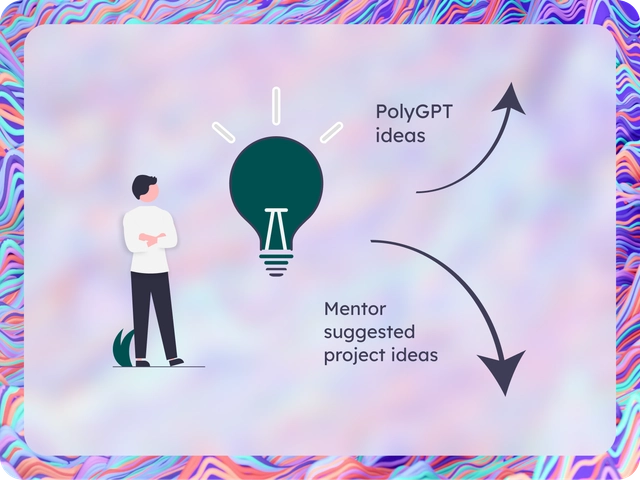Meet PolyGPT, our AI-powered Project Idea Generator
Tell PolyGPT your favorite subject and a few hobbies you're passionate about to generate personalized project ideas.
Log in to explore PolyGPTExplore project ideas with the help of PolyGPT
See your personalized project ideas come to life with PolyGPT! Log in to brainstorm ideas.

We know the jump from your interests to a research project idea can be tricky.
That's why we've built tools to help you find the perfect project idea to lay the foundation of a successful project. Simply copy your favorite idea to your clip board, and paste it in the project idea section of the application.

Browse project ideas by Polygence mentors
The Impossible Clock: Simulating a Discrete Time Crystal
In classical physics, if you constantly shake a box of particles, they will absorb energy, heat up, and eventually become a chaotic mess—a process known as thermalization. However, in 2012, physicists proposed a strange new phase of matter that evades this fate: the discrete time crystal. In this project, we will simulate a quantum spin chain that is periodically kicked by a laser pulse but, counter-intuitively, refuses to heat up or become chaotic. Drawing on my background in non-equilibrium quantum dynamics, I will guide the student in simulating a Floquet system using Python and exact diagonalization. We will model a chain of spins with strong interactions and disorder. The core physics concept we will explore is many-body localization (MBL), a phenomenon where disorder prevents energy from spreading through the system. This localization acts as a shield, allowing the system to maintain its order despite the constant driving force that tries to heat it up. The student will demonstrate the hallmark signature of this phase: period doubling. If we kick the system every T seconds, a normal system would respond every T seconds. The time crystal, however, will break this symmetry and stubbornly respond every 2T seconds, ticking at its own rigid pace. The student will verify the robustness of this phase by adding noise to the drive and proving that the crystal remains stable, demonstrating a state of matter that is rigidly ordered in time. Potential outcomes include a research paper on "Robustness of Subharmonic Oscillations in Disordered Spin Chains," featuring a time-series graph showing how the system maintains perfect oscillation without thermalizing, compared to a clean system that quickly becomes chaotic.
Physics, Computer Science, Quantitative

Attention is All You Need for Physics? Transformers vs. CNNs in Topological Phase Transitions
In classical physics, identifying a phase of matter is usually straightforward: ice looks different from water because the atoms arrange themselves in a clear, local pattern. However, the quantum world is home to topological phases, states of matter defined not by local geometry but by global mathematical knots that cannot be undone by simple changes. In this project, we will use the 2D XY Model, a Nobel Prize-winning concept involving the pairing and unbinding of magnetic vortices, as a testbed to investigate a fundamental question in artificial intelligence: Can a neural network see topology? This problem presents a unique challenge for standard deep learning. Convolutional neural networks (CNNs), the gold standard for image recognition, are designed to detect local features like edges or textures. They often fail to capture the long-range correlations required to identify the Kosterlitz-Thouless (KT) transition in the 2D XY model, where a vortex on one side of the material is mathematically paired with an anti-vortex far away. To solve this, we will pit the CNN against a Vision Transformer (ViT), the architecture behind modern Large Language Models, which uses a self-attention mechanism to analyze global relationships between all parts of the system simultaneously. The student will generate synthetic datasets of spin configurations using Monte Carlo simulations and train both architectures to predict the topological phase. Beyond simple accuracy metrics, the core of this project is interpretability. By visualizing the attention maps of the transformer, the student will be able to see exactly which parts of the lattice the AI looks at to make its decision. This will result in a research paper on "Benchmarking Attention Mechanisms on Topological Datasets," providing a visual and mathematical argument for why certain AI architectures are better suited for the non-local reality of quantum physics.
Physics, Computer Science, Quantitative

Building the Quantum Internet: Benchmarking Teleportation Fidelity on Noisy Hardware
Quantum teleportation is not merely a science fiction trope but the foundational protocol required for the future Quantum Internet. While the theory is well-established, real-world implementation faces significant hurdles due to hardware noise (thermal fluctuations and radiation that cause loss of information). In this project, we will move beyond theoretical textbook exercises to investigate why this protocol often fails in practice. Drawing on my background in quantum engineering and noise mitigation, I will guide the student in programming the teleportation protocol using Python and Qiskit, executing the code on actual IBM Quantum processors via the cloud rather than relying solely on perfect simulators. The core research question will focus on benchmarking the fidelity of information transfer across different physical distances on the chip. Current quantum processors, such as IBM’s Eagle or Heron chips, utilize a specific lattice architecture where qubits are not fully connected to one another. Consequently, teleporting information between "distant" qubits requires the quantum compiler to insert a chain of SWAP gates to physically move the information across the chip. These gates are computationally expensive and introduce significant error. The student will systematically vary the topological distance between the sender and receiver qubits, comparing neighbor teleportation versus long-distance teleportation, to quantify exactly how hardware architecture impacts data integrity. This study will result in a research paper on "Quantifying Information Loss in Quantum Teleportation Protocols", providing empirical data on the limitations of current Noisy Intermediate-Scale Quantum (NISQ) devices. By correlating the number of SWAP gates with the decrease in teleportation fidelity, the student will generate new, experimental data that highlights the practical challenges of scaling quantum networks. This project offers a tangible way to explore the inverse problem of quantum computing: characterizing the hidden noise of a system by observing the degradation of a known signal.
Physics, Computer Science, Quantitative

Design Competition Submission
I can support students preparing work for architecture competitions by guiding them through both the design process and the storytelling needed to present their work effectively. With experience in research-driven design, visual communication, and 3D modeling tools, I can help refine concepts, strengthen narratives, and develop clear, compelling graphics.
Arts

Understanding the Emotional and Social Challenges Faced by Teenagers Supporting a Parent With Cancer: A Qualitative Analysis
This project aims to explore how teenagers experience and cope with having a parent undergoing cancer treatment. While current literature focuses on patients and adult caregivers, the voices of adolescent family members are often overlooked. This project would entail conducting semi-structured interviews and performing qualitative analysis to learn how cancer affects family dynamics, school life, emotional well-being, and social support for teenage cancer caregivers.
Cancer, Psychology, Medicine

Immune Cell Superheroes
What if T cells, B cells, and macrophages were superheroes with special powers? In this project, you’ll learn the basics of the immune system and then turn those ideas into a creative comic, storybook, or animation.
Cancer, Biology

Which Cancer Treatment Wins?
Many cancers have more than one treatment option, like chemotherapy vs. targeted therapy or targeted therapy vs. immunotherapy. In this project, you’ll choose one cancer and compare two different treatment types in terms of how they work, side effects, and outcomes.
Cancer, Biology

Patient-Friendly Guide to Immunotherapy
Lots of patients hear big words like “checkpoint inhibitor” or “CAR T cells” and feel overwhelmed. In this project, you’ll learn the science behind one type of cancer immunotherapy and then create a friendly guide for patients and families.
Cancer, Biology

From Lab Discovery to Patent to Pill Bottle
How does a molecule discovered in a lab eventually become a medicine at the pharmacy? In this project, you’ll pick one drug/therapeutic and trace its journey from scientific discovery, to patents, to clinical trials, to patients. You’ll see how science, law, and business all connect.
Cancer, Biology

Should We Be Allowed to Patent Life? Ethics of Biotech Patents
Can you own a gene? A microbe? A genetically modified plant? In this project, you’ll explore famous court cases and ethical debates around patenting living things. You’ll analyze pro/con arguments and then create your own position statement or policy proposal.
Cancer, Biology
